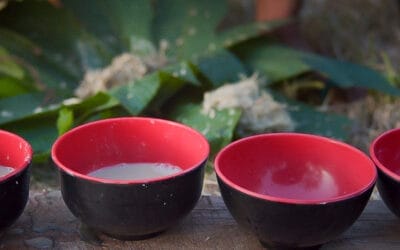Kava Plant Propagation
 Kava is an interesting plant, particularly when it comes to kava cultivation. Firstly, a kava plant is sterile, meaning that it can’t reproduce naturally. Female flowers are very rare and do not produce fruit or seeds, even when a plant is hand-pollinated. This can make kava cultivation a bit complicated.
Kava is an interesting plant, particularly when it comes to kava cultivation. Firstly, a kava plant is sterile, meaning that it can’t reproduce naturally. Female flowers are very rare and do not produce fruit or seeds, even when a plant is hand-pollinated. This can make kava cultivation a bit complicated.
Kava farmers have to use propagation to plant and grow new kava plants. Each kava plant has to be specifically cultivated from a node on a segment of the stalk. Farmers will take the stem of an existing plant and chop it into 3” – 4” long pieces. Traditionally, these stem cuttings are then planted directly into the ground and nurtured for 3-5 years for a mature plant to grow.
Because of the growing demand for kava it is more common now, for kava plant propagation, from node stems to healthy seedlings, to take place in a nursery. And new aid-for-trade programs are seeking to support kava farmers and the development of quality kava in Fiji, Vanuatu, and Samoa. These programs promote the expansion of kava plant nurseries along with the introduction of standards, training, testing methods.
Kava Plant Seedlings to Soil
 Kava plant seedlings are transferred back into moist, loose soil. This type of soil allows for the roots to breathe, extend and grow stronger.
Kava plant seedlings are transferred back into moist, loose soil. This type of soil allows for the roots to breathe, extend and grow stronger.
Typically kava plants need to be planted initially in shady spots to support their early months. They thrive in climates where rainfall is plentiful, the soil remains moisturized, and temperatures and humidity are high all year round.
As with all farming, adverse weather conditions pose the most significant risk for kava farmers. Drought conditions and the opposite, tropical cyclones, which are common in the South Pacific, and can cause flooding and landslides. These weather conditions are all the enemy of the kava farmer. Loss of a kava crop can cause real financial hardship for kava farmers and their communities. Many Pacific Island communities depend on the fruits of the land for their living and livelihoods.
The eruption of the Manaro Volcano on the island of Ambae, Vanuatu, was the latest natural disaster to affect kava farmers. The farmers there were forced to evacuate along with all islanders. They and their families will have to start again and rebuild their lives on a new island.
Kava Plant Harvesting
Ideally, kava plants should be allowed to grow for 3-5 years into bushy shrubs before they are harvested. When kava plants are allowed to mature, it also allows the kavalactones, (the ingredients that provide kava’s beneficial mind and body relaxation effects), to fully develop. At this age, kava plants generally grow to around 6 feet in height. As a kava plant grows its stalk thickens and it is common for additional stalks to sprout from the original stem. The all-important, kava root can reach a depth of around 25 inches.
When digging up a mature kava plant, farmers take care to extract all the valuable lateral roots, the part of the plant that contains the highest concentration of kavalactones.
Post-Harvest Kava Preparation: Drying, Pounding, and Grinding
Once harvested, the next step is the separation of the stalks which are set aside to provide the nodes for future kava plant propagation, from the stem/stump (known in Fiji as lawena) and the roots, (known in Fiji as waka), of the kava plant from each other.
The stumps and roots are then washed thoroughly to remove dirt. The stumps go through an additional process of peeling to remove the outer skin.
The stump and kava root are then placed into bins or onto plastic sheets, on top of rocks, or on corrugated iron roofing panels and either laid out in the sun to dry or placed into drying houses. Once completely dry the kava is then pounded or ground into a powder and ready for consumption or export. How kava is pound or ground differs by island. The traditional method on Vanuatu is to grind the kava down using limestone on a slab. On other islands, a pestle and mortar method is used.
Local Family Farmers
When we think of farming in the U.S we often think of the west coast or mid-west and large-scale farming operations. Kava farming is completely the opposite. It remains a family affair. Kava farmers are independent, small-scale, local family farmers. They plant kava alongside other crops as a means of bringing in additional money. These additional revenues are used to buy a car or perhaps send their children to university. We focus on sourcing kava from family farmers for this reason. Also, over the last 10+ years, we’ve discovered it’s the best way to get consistently high-quality kava to sell in the Kalm with Kava shop.
Now that you’ve learned how to grow kava, the next time you chug down a shell and cheer “Bula! ” make sure to remember the family farmers who helped bring that kava to you. We’re eternally grateful for their commitment to high-quality kava cultivation and their patience and persistence in the face of adversity, growing demand and commercial pressures.
Learn more about what kava is and the culture of kava drinking in the Pacific Islands.
We will always love, respect, and honor community traditions linked to kava cultivation and the role of kava in the cultural life of South Pacific islanders. We hope you will too.



